Who's Who
Henri IV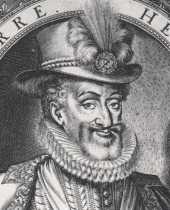
Henri IV (Henri de Navarre, Henri de Bourbon), 1553-1610, first Bourbon
king of France, was the son of Antoine de Bourbon and Jeanne d'Albret.
On her death he succeeded to the kingdom of Navarre (1572). He took leadership
of the Huguenot (Protestant) party in 1569. His marriage in 1572 with Marguerite
de Valois was the occasion for the massacre of St. Bartholomew's Day. Henri
saved his life by abjuring Protestantism, but in 1576 he escaped from his
virtual imprisonment at court and returned to Protestantism. When in 1584
Henri III named him heir presumptive, the Catholic League, headed by Henri
3rd Duc de Guise refused to recognize him and persuaded Henri III to send
an army to force his conversion. In the resulting "War of the Three Henries,"
Henry de Navarre defeated Henri III at Coutras (1587) but came to the king's
support in the troubles of 1588, and after Henri III's death (1589) defeated
the League forces at Arques (1589) and Ivrey (1590); he was unable to enter
Paris until 1594, after he had abjured Protestantism -- allegedly with
the remark, "Paris is well worth a Mass." His war with Spain, the ally
of the League, ended in 1598 with the Treaty of Vervins. In 1598 he also
established religious toleration through the Edict of Nantes. With his
minister Sully he spent the rest of his reign restoring order, industry,
and trade. His slogan, "A chicken in every peasant's pot every Sunday,"
has remained famous. In 1600 he married Marie de' Medici, having had his
earlier marriage annulled. His gallantry and wit, his concern for the common
people, and his exploits with the ladies have become legendary. --Columbia-Viking
desk encyclopedia, 1953
Henri III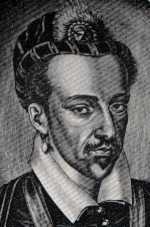
Henri III, 1551-89, was elected king of Poland in 1573 but returned to
France in 1574 to succeed his brother Charles IX. His reign was almost
continually disturbed by the Wars of Religion. The death in 1584 of his
brother François made him the last male member of the House of Valois.
His recognition of Henri de Navarre (later Henri IV) as heir presumptive
was opposed by Henri, 3rd Duc de Guise, head of the Catholic League (the
"War of the Three Henrys" resulted). Having procured the murder of Guise
(1588), the king was faced with a revolt of the League and was expelled
from Paris. Henri de Navarre came to his aid, but Henri III was assassinated
in the siege by Jacques Clément, a fanatic monk. --Columbia-Viking
desk encyclopedia, 1953
Henri III is something of an historical enigma. The beautiful sketches
of the royal family by Clouet show a young man with compellingly soulful
eyes; later there is a certain haunted quality to them. He was the military
hero of Jarnac and Montcontour (notable royal victories over the Huguenots),
a keen blade and afficionado of the fence, who occasionally dressed in
women's clothing and whose taste for luxury was considered the height of
decadence. He kept a retinue of "mignons" -- his fanatically loyal courtiers,
pretty boys with sharp swords who picked duels with the retainers of his
enemies. He was sincerely, if intermittently, religious, establishing congregations
of Penitents in Paris and walking barefoot in their processions, flagellating
himself (there is a certain masochistic quality to his outbreaks of piety).
In 1577 he gave the Protestants all the rights they would later have in
the Edict of Nantes in 1598, although these were annulled over the years
under pressure from the Catholic wing. In the end he valued blood ties
over religion, and named Henri de Navarre his heir on his deathbed. History
remembers him as an indolent "Prince of Sodom", but he was the most intelligent
and capable of Catherine's brood. Destined to be the last of the Valois,
he nevertheless kept his throne for 15 years in the face of chaos. --c.
t. iannuzzo
Web Resources:
House of Guise 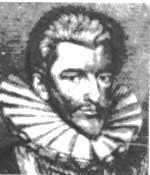
French ducal family, founded as cadet branch of house of Lorraine by Claude
de Lorraine, first duc de Guise, 1496-1563, whom François I made
duke and peer. His daughter Mary of Guise married James V of Scotland and
was mother of Mary Queen of Scots. His sons François de Lorraine,
2nd duc de Guise, 1519-1563, and Charles de Guise, Cardinal de Lorraine,
1525-1574, controlled French politics in the reign of François II,
first husband of Mary Queen of Scots. Championing the Catholic cause against
the Huguenots, they cruelly suppressed the conspiracy of Amboise (1560).
After François' death they opposed the tolerant policy of Catherine
de'Medici [queen mother] and provoked the outbreak of the Wars of Religion
(1562). François defeated the Huguenots at Dreux, but was assassinated
shortly afterward. Charles negotiated for Spanish help and held power at
court 1567-1570. Henri de Lorraine (pictured), 3rd duc de Guise
, 1550-88, son of François, helped to plan the massacre of St. Bartholomew's
Day and after 1576 formed the Catholic League. Immensely ambitious and
popular [called "the people's king"], he instigated the revolt of Paris
against King Henri III (1588) and took control of the city. After an ostensible
conciliation, the king had him murdered. His brother, Louis de Lorraine,
Cardinal de Guise 1555-58, was killed at the same time. Leadership of the
League devolved upon their brother, Charles, duc de Mayenne, who fought
against Henri IV until 1596. -Columbia-Viking desk encyclopedia, 1953
Catherine de' Medici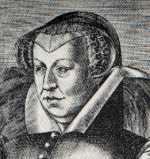
Catherine de'Medici, 1519-1589. The wife of King Henri II, daughter of
the Florentine ducal family, and niece of Pope Leo X, three of Catherine's
four sons came successively to the throne of France after the premature
death of their father in a tournament accident (François II, Charles
IX, Henri III). Her eldest daughter, Elizabeth, married Phillip II of Spain,
her daughter Claude married the Duke of Lorraine (it was at the celebration
of this marriage that the fateful accident occurred), and her youngest
daughter Marguerite married Henri de Navarre (Henri IV). Catherine has
been largely reviled by history. As a foreign women wielding the power
behind the throne of France during one of the worst times in its history,
it probably could not be otherwise. She has been largely blamed as the
mastermind of Admiral Coligny's murder and the St. Bartholomew's Day Massacre
(surely Jehan du Lac believes it), but her role is hard to know for absolutely
certain. She did bring many aspects of Italian culture to France, including
the Commedia dell'Arte, ballet, fine cooking and table manners, and Italian
bankers. Her political maneuvering, while not winning her any great popularity,
kept the throne of France intact for 30 years, long enough for the Bourbons
to inherit it. Her life-long rival, Henri IV, paid her this tribute after
his victory was complete and his throne secure: "What could the poor woman
do with five little children on her arms, after the death of her husband,
and two families in France, ours and the Guises, attempting to encroach
on the Crown? Was she not forced to play strange parts to deceive the one
and the other and yet, as she did, to protect her children, who reigned
in succession by the wisdom of a woman so able? I wonder that she did not
do worse!" --c. t. iannuzzo
Web Resources:
Gabrielle d'Estrees
Gabrielle d'Estrees, 1573-1599. King Henri IV's current mistress. Henri
met her in November 1590, in Picardie. He became quite infatuated with
her. Although he was never a one-woman man, she held the ascendency until
her death in 1599. She came from a family that had provided manipulative
mistresses to the royalty of France for a hundred years. Gabrielle gave
Henri three children, two of them sons. The eldest, César,
was named Duc de Vendôme, one of Henri's ancestral properties.
Henri and his wife, Queen Margot, have lived apart for many years now and
there have never been any legitimate heirs. This poses a potential problem
for the future stability of France, and Henri has already approached Margot
about having their marriage annulled (which she refuses to grant as long
as Gabrielle is in the picture). Rumors are beginning to fly that Henri
would like to marry Gabrielle and legitimize her children, thereby providing
instant heirs. Most of the nobility probably don't think this is a good
idea. --c. t. iannuzzo
This picture of Two
Women Bathing is reputed to be Gabrielle (on the right) and one of
her sisters.
Philip II
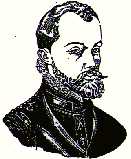
Philip II (b. May 21, 1527, d. Sept. 13, 1598), is king of Spain and
rules a vast domain that includes Spain, its possessions in America and
Italy, the Low Countries, and Portugal. Philip rules his vast lands from
Madrid (and the great monastery-palace that he has constructed at the Escorial)
with hard work, attention to detail and a suspicious eye. At almost 70
years old, he is still a formidable figure.
Revolt broke out in the Low Countries in 1566, and Philip--who is a
devout Roman Catholic --became embroiled in a struggle that lasted until
1648. English and French efforts on behalf of the Dutch rebels led Philip
to attempt an invasion of England in 1588. The disastrous results were
the now infamous Rout of the Spanish Armada by Drake. Since then he has
engaged in a series of costly and inconclusive adventures in France. The
expense of these efforts and of the struggle with the Turks was more than
even the enormous resources of his empire could bear, precipitating the
economic decline that left Spain prostrate in the next century. Although
his forces defeated the Turks at Lepanto in 1571 and recently have been
regaining the southern part of the Netherlands, Philip's life has been
one of near-constant war.
Philip's private life was a difficult as his public one. Maria of Portugal,
his first wife, died in1545 after only 2 years of marriage. Her son was
Don Carlos, who was so dangerous and violent that Phillip was forced to
imprison him. From 1554-1558 he was married to Mary I of England, in an
unhappy marriage that produce no children. In 1568, when Don Carlos and
Philip's third wife, Elizabeth of Valois (sister of Henri III, with whom
he had two daughters, the eldest of which he proposed as heir to the crown
of France after the death of Henri III), died within a few months of each
other, Philip was accused of murdering both of them. Philip married Anne
of Austria in 1570; they have had four sons, three of whom died in childhood.
Phillip is a staunch supporter of the Catholic church, and has put down
two internal rebellions in the past twenty years (the Moriscos in1570 and
the Aragonese in 1591). He is generally seen as a stern but just ruler
by the Spanish. --a. newman
Web Resources:
Elizabeth I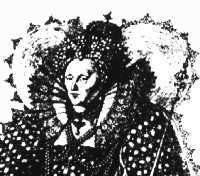
Elizabeth I, 1533-1603, queen of England 1558-1603. Daughter of Henry VIII
and Anne Boleyn, she was declared illegitimate after her mother's execution.
Parliament reestablished her in succession in 1544. Imprisoned as rallying
point for discontented Protestants, she regained freedom by outward conformity
to Catholicism. On her succession England's low fortunes included religious
strife, a huge government debt, and failure in wars with France. Her reign
took England through one of its greatest periods. It produced such men
as Shakespeare, Spenser, Francis Bacon, and Walter Raleigh. It saw the
country united to become a first-rate European power with a great navy.
It saw commerce and industry propser and colonization begin. Her Tudor
concept of strong rule and need for popular support helped her select excellent
counsellors. She reestablished Anglicanism and measures against Catholics
grew harsher. Important measures enacted included stablization of labor
conditions, currency reforms, poor laws, and acts to encourage agriculture,
commerce, and manufacturing. Elizabeth began a policy of peace and her
series of diplomatic maneuvers eventually defeated Spain and stalemated
France. Treaty of Edinburgh (1560) started policy of supporting Protestant
lords against Catholics. After abdication of Mary Queen of Scots from Scottish
throne, Elizabeth gave her refuge, kept her prisoner, and executed her
only after plots to seat Mary on English throne [there are other points
of view on this subject.] By marriage negotiations with Francis, duke
of Alençon and Anjou, she secured (1572) defence alliance against
Spain and, later, French aid for the Dutch against Spain, who now emerged
as England's main enemy. Philip II of Spain, whose offer of marriage Elizabeth
had refused in 1559, planned Spanish Armada expedition as reprisal against
English raids on Spanish shipping. Defeat of Armada broke power of Sain.
Vain, fickle in bestowing favors, prejudiced, vacillating, and parsimonious,
she was also highly aware of responsibility of rule and immensely courageous.
--Columbia-Viking desk encyclopedia, 1953
Web resources:
 Home
to Poulet Gauche
Home
to Poulet Gauche Bibliography
Bibliography







